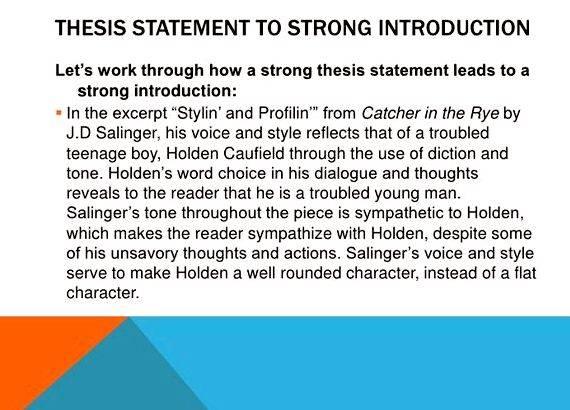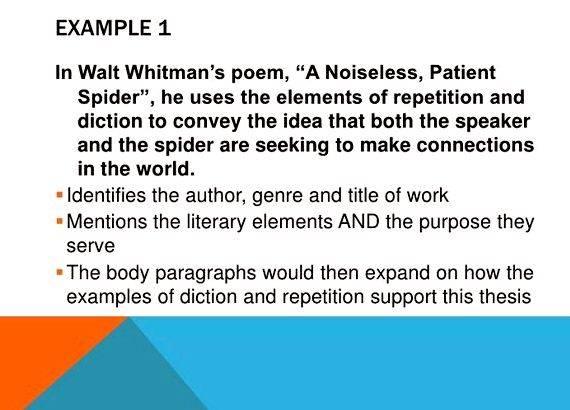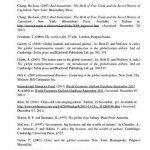First and last impressions are important in any part of life, especially in writing. This is why the introduction and conclusion of any paper – whether it be a simple essay or a long research paper – are essential. Introductions and conclusions are just as important as the body of your paper. The introduction is what makes the reader want to continue reading your paper. The conclusion is what makes your paper stick in the reader’s mind.
Introductions
Your introductory paragraph should include:
1) Hook: Description, illustration, narration or dialogue that pulls the reader into your paper topic. This should be interesting and specific.
2) Transition: Sentence that connects the hook with the thesis.
3) Thesis: Sentence (or two) that summarizes the overall main point of the paper. The thesis should answer the prompt question.
The examples below show are several ways to write a good introduction or opening to your paper. One example shows you how to paraphrase in your introduction. This will help you to understand the idea of writing sequences with that use a hook, transition and thesis statement.
Thesis Statement Opening
This is the traditional style of opening a paper. This is a “mini-summary” of your paper.
Gallaudet University, the only liberal arts college for deaf students in the world, is world-renowned in the field of deafness and education of the deaf. Gallaudet is also proud of its charter which was signed by President Abraham Lincoln in year of 1864. All of this happened in Gallaudet’s history, Gallaudet could not live without its rich history and fame to two men: Amos Kendall and Edward Miner Gallaudet.
Hook: a specific example or story that interests the reader and introduces the topic.
Transition: connects the hook to the thesis statement
Thesis: summarizes overall claim of the paper
Opening with a Story (Anecdote)
A good way of catching your reader’s attention is by sharing a story that sets up your paper. Sharing a story gives a paper a more personal feel and helps make your reader comfortable.
This example was borrowed from Jack Gannon’s The Week the World Heard Gallaudet (1989):
Astrid Goodstein, a Gallaudet faculty member, entered the beauty salon for her regular appointment proudly wearing her DPN button. (“I was married to that button that week!” she later confided.) When Sandy, her regular hairdresser, saw the button, he spoke and gestured, “Never! Never! Never!” Offended, Astrid turned around and headed for the door, but stopped short of leaving. She decided to keep her appointment, confessing later that at that moment her sense of principles had lost out to her vanity. Later she realized that her hairdresser had thought she was pushing for a deaf U.S. President.
Hook: a specific example or story that interests the reader and introduces the topic.
Transition: connects the hook to the thesis statement
Thesis: summarizes overall claim of the paper
Specific Detail Opening
Giving specific details about your subject appeals to your reader’s curiosity and helps establish a visual picture of what your paper is about.
Hands flying, green eyes flashing, and spittle spraying Jenny howled at her younger sister Emma.

People walked by gawking at the spectacle as Jenny’s grunts emanated through the mall. Emma sucked at her thumb trying to appear nonchalant. Jenny’s blond hair stood almost on end. Her hands seemed to fly so fast that her signs could barely be understood. Jenny was angry. Very angry.
Hook: a specific example or story that interests the reader and introduces the topic.
Transition: connects the hook to the thesis statement
Thesis: summarizes overall claim of the paper
Open with a Quotation
Another method of writing an introduction is to open with a quotation. This method makes your introduction more interactive and more appealing to your reader.
“People paid more attention to the way I talked than what I said!” exclaimed the woman from Brooklyn, New York in the movie American Tongues. This young woman’s home dialect interferes with people taking her seriously because they see her as a cartoonish stereotype of a New Yorker. The effects on this woman indicate the widespread judgment that occurs about nonstandard dialects. People around America judge those with nonstandard dialects because of _____________ and _____________. This type of judgment can even cause some to be ashamed of or try to change their language identity.*
Hook: a specific example or story that interests the reader and introduces the topic.
Transition: connects the hook to the thesis statement
Thesis: summarizes overall claim of the paper
Open with an Interesting Statistic
Statistics that grab the reader help to make an effective introduction.
American Sign Language is the second most preferred foreign language in the United States. 50% of all deaf and hard of hearing people use ASL.* ASL is beginning to be provided by the Foreign Language Departments of many universities and high schools around the nation.
* The statistics are not accurate. They were invented as an example.
Hook: a specific example or story that interests the reader and introduces the topic.
Transition: connects the hook to the thesis statement
Thesis: summarizes overall claim of the paper
Question Openings
Possibly the easiest opening is one that presents one or more questions to be answered in the paper. This is effective because questions are usually what the reader has in mind when he or she sees your topic.
Is ASL a language? Can ASL be written? Do you have to be born deaf to understand ASL completely? To answer these questions, one must first understand exactly what ASL is. In this paper, I attempt to explain this as well as answer my own questions.
Hook: a specific example or story that interests the reader and introduces the topic.
Transition: connects the hook to the thesis statement
Thesis: summarizes overall claim of the paper
Source. *Writing an Introduction for a More Formal Essay. (2012). Retrieved April 25, 2012, from flightline.highline.edu/wswyt/Writing91/handouts/hook_trans_thesis.htm
Conclusions
The conclusion to any paper is the final impression that can be made. It is the last opportunity to get your point across to the reader and leave the reader feeling as if he or she learned something. Leaving a paper “dangling” without a proper conclusion can seriously devalue what was said in the body itself. Here are a few effective ways to conclude or close your paper.
Summary Closing
Many times conclusions are simple re-statements of the thesis. Many times these conclusions are much like their introductions (see Thesis Statement Opening).
Because of a charter signed by President Abraham Lincoln and because of the work of two men, Amos Kendall and Edward Miner Gallaudet, Gallaudet University is what it is today – the place where people from all over the world can find information about deafness and deaf education. Gallaudet and the deaf community truly owe these three men for without them, we might still be “deaf and dumb.”
Close with a Logical Conclusion
This is a good closing for argumentative or opinion papers that present two or more sides of an issue. The conclusion drawn as a result of the research is presented here in the final paragraphs.
As one can see from reading the information presented, mainstreaming deaf students isn’t always as effective as educating them in a segregated classroom. Deaf students learn better in a more one-on-one basis like they can find in a school or program specially designed for them. Mainstreaming is just that; deaf students get lost in the mainstream.
Real or Rhetorical Question Closings
This method of concluding a paper is one step short of giving a logical conclusion. Rather than handing the conclusion over, you can leave the reader with a question that causes him or her to draw his own conclusions.
Why, then, are schools for the deaf becoming a dying species?
Close with a Speculation or Opinion
This is a good style for instances when the writer was unable to come up with an answer or a clear decision about whatever it was he or she was researching.
Through all of my research, all of the people I interviewed, all of the institutions I visited, not one person could give me a clear-cut answer to my question. Can all deaf people be educated in the same manner? I couldn’t find the “right” answer. I hope you, the reader, will have better luck.
Close with a Recommendation
A good conclusion is when the writer suggests that the reader do something in the way of support for a cause or a plea for them to take action.
American Sign Language is a fast growing language in America. More and more universities and colleges are offering it as part of their curriculum and some are even requiring it as part of their program. This writer suggests that anyone who has a chance to learn this beautiful language should grab that opportunity.
Updated August 18, 2015
Tutorial Instructional Programs
Gallaudet University, Washington, D.C.
Comments and questions- email us
This page is brought to you by the OWL at Purdue (https://owl.english.purdue.edu/). When printing this page, you must include the entire legal notice at bottom.
Tips and Examples for Writing Thesis Statements
This resource provides tips for creating a thesis statement and examples of different types of thesis statements.
Contributors: Elyssa Tardiff, Allen Brizee
Last Edited: 2014-02-10 10:44:43
Tips for Writing Your Thesis Statement
1. Determine what kind of paper you are writing:
- An analytical paper breaks down an issue or an idea into its component parts, evaluates the issue or idea, and presents this breakdown and evaluation to the audience.
- An expository (explanatory) paper explains something to the audience.
- An argumentative paper makes a claim about a topic and justifies this claim with specific evidence. The claim could be an opinion, a policy proposal, an evaluation, a cause-and-effect statement, or an interpretation. The goal of the argumentative paper is to convince the audience that the claim is true based on the evidence provided.
If you are writing a text that does not fall under these three categories (e.g. a narrative), a thesis statement somewhere in the first paragraph could still be helpful to your reader.
2. Your thesis statement should be specificit should cover only what you will discuss in your paper and should be supported with specific evidence.
3. The thesis statement usually appears at the end of the first paragraph of a paper.
4. Your topic may change as you write, so you may need to revise your thesis statement to reflect exactly what you have discussed in the paper.
Thesis Statement Examples
Example of an analytical thesis statement:
An analysis of the college admission process reveals one challenge facing counselors: accepting students with high test scores or students with strong extracurricular backgrounds.
The paper that follows should:
- Explain the analysis of the college admission process
- Explain the challenge facing admissions counselors
Example of an expository (explanatory) thesis statement:
The life of the typical college student is characterized by time spent studying, attending class, and socializing with peers.
The paper that follows should:
- Explain how students spend their time studying, attending class, and socializing with peers
Example of an argumentative thesis statement:
High school graduates should be required to take a year off to pursue community service projects before entering college in order to increase their maturity and global awareness.
The paper that follows should:
- Present an argument and give evidence to support the claim that students should pursue community projects before entering college
1995-2016 by The Writing Lab The OWL at Purdue and Purdue University. All rights reserved. This material may not be published, reproduced, broadcast, rewritten, or redistributed without permission. Use of this site constitutes acceptance of our terms and conditions of fair use .






 Magandang pamagat sa thesis writing
Magandang pamagat sa thesis writing Acknowledgement sample for group thesis writing
Acknowledgement sample for group thesis writing Thesis proposal sample pdf file
Thesis proposal sample pdf file Nit kurukshetra phd thesis writing
Nit kurukshetra phd thesis writing Tortillas by jose antonio burciaga thesis writing
Tortillas by jose antonio burciaga thesis writing






